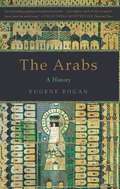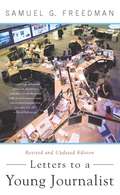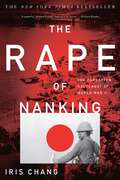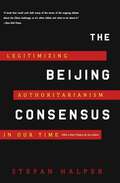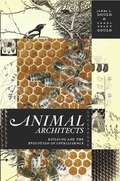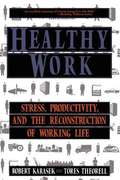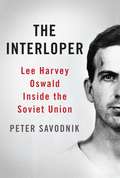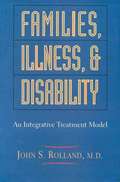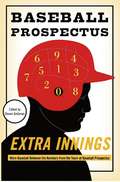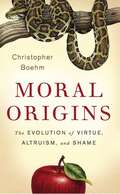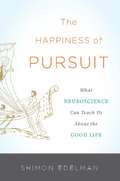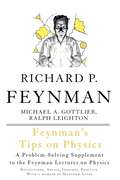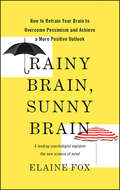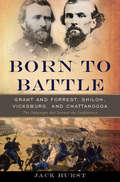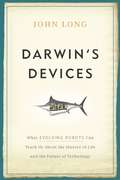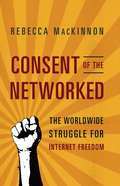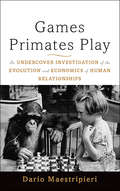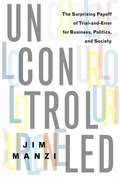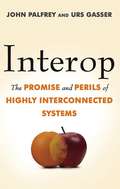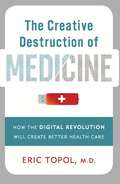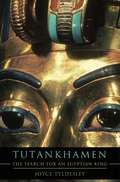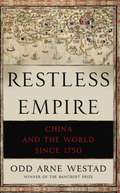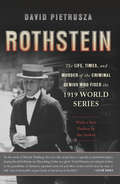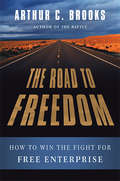- Table View
- List View
The Arabs
by Eugene RoganTo American observers, the Arab world often seems little more than a distant battleground characterized by religious zealotry and political chaos. Years of tone-deaf US policies have left the region powerless to control its own destiny-playing into a longstanding sense of shame and impotence for a once-mighty people. In this definitive account, preeminent historian Eugene Rogan traces five centuries of Arab history, from the Ottoman conquests through the British and French colonial periods and up to the present age of unipolar American hegemony. The Arab world is now more acutely aware than ever of its own vulnerability, and this sense of subjection carries with it vast geopolitical consequences. Drawing from Arab sources little known to Western readers, Rogan’sThe Arabswill transform our understanding of the past, present, and future of one of the world’s most tumultuous regions.
Letters to a Young Journalist, Revised and Updated Edition
by Samuel G. FreedmanOver the course of a thirty-year career, Samuel Freedman has excelled both at doing journalism and teaching it, and he passionately engages both of these endeavors in the pages of this book. As an author and journalist, Freedman has produced award-winning books, investigative series, opinion columns, and feature stories and has become a specialist in a wide variety of fields. As a teacher, he has shared his expertise and experience with hundreds of students, who have gone on to succeed in both print and broadcast media. In Letters to a Young Journalist, Freedman conducts an extended conversation with young journalists-from kids on the high school paper to graduates starting their first jobs. Whether he's talking about radio documentaries or TV news shows, Internet blogs, or backwater beats, shoeleather research or elegant prose, his goal is to explore the habits of mind that make an excellent journalist. It is no secret that journalism's mission is seriously imperiled these days, and Freedman's provocative ideas and fascinating stories offer students and journalists at all levels of experience wise guidance and professional inspiration.
The Rape Of Nanking: The Forgotten Holocaust Of World War II
by Iris ChangIn December 1937, in what was then the capital of China, one of the most brutal massacres in the long annals of wartime barbarity occurred. The Japanese army swept into the ancient city of Nanking (Nanjing) and within weeks not only looted and burned the defenseless city but systematically raped, tortured, and murdered more than 300,000 Chinese civilians. Amazingly, the story of this atrocity-one of the worst in world history-continues to be denied by the Japanese government. Based on extensive interviews with survivors and newly discovered documents in four different languages (many never before published), Iris Chang, whose own grandparents barely escaped the massacre, has written what will surely be the definitive, English-language history of this horrifying episode-one that the Japanese have tried for years to erase from public consciousness. The Rape of Nanking tells the story from three perspectives: that of the Japanese soldiers who performed it; of the Chinese civilians who endured it; and finally of a group of Europeans and Americans who refused to abandon the city and were able to create a safety zone that saved almost 300,000 Chinese. It was Chang who discovered the diaries of the German leader of this rescue effort, John Rabe, whom she calls the "Oskar Schindler of China. ” A loyal supporter of Adolf Hitler but far from the terror planned in his Nazi-controlled homeland, he worked tirelessly to save the innocent from slaughter. But this book does more than just narrate details of an orgy of violence; it attempts to analyze the degree to which the Japanese imperial government and its militaristic culture fostered in the Japanese soldier a total disregard for human life. Finally, it tells one more shocking story: Despite the fact that the death toll at Nanking exceeded the immediate deaths from the atomic blasts at Hiroshima and Nagasaki combined (and even the total wartime casualty count of entire European countries), the Cold War led to a concerted effort on the part of the West and even the Chinese to court the loyalty of Japan and stifle open discussion of this atrocity. Indeed, Chang characterized this conspiracy of silence, which persists to this day, as "a second rape. ”
The Beijing Consensus: Legitimizing Authoritarianism in Our Time
by Stefan HalperBeijing presents a clear and gathering threat to Washington-but not for the reasons you think. China’s challenge to the West stems from its transformative brand of capitalism and an entirely different conception of the international community. Taking us on a whirlwind tour of China in the world-from dictators in Africa to oligarchs in Southeast Asia to South American strongmen-Halper demonstrates that China’s illiberal vision is rapidly replacing that of the so-called Washington Consensus. Instead of promoting democracy through economic aid, as does the West, China offers no-strings-attached gifts and loans, a policy designed to build a new Beijing Consensus. The autonomy China offers, together with the appeal of its illiberal capitalism, have become the dual engines for the diffusion of power away from the West. The Beijing Consensus is the one book to read to understand this new Great Game in all its complexity.
Animal Architects: Building and the Evolution of Intelligence
by James L. Gould Carol Grant GouldAnimal behavior has long been a battleground between the competing claims of nature and nurture, with the possible role of cognition in behavior as a recent addition to this debate. There is an untapped trove of behavioral data that can tell us a great deal about how the animals draw from these neural strategies: The structures animals build provide a superb window on the workings of the animal mind. Animal Architects examines animal architecture across a range of species, from those whose blueprints are largely innate (such as spiders and their webs) to those whose challenging structures seem to require intellectual insight, planning, and even aesthetics (such as bowerbirds’ nests, or beavers’ dams). Beginning with instinct and the simple homes of solitary insects, James and Carol Gould move on to conditioning; the "cognitive map” and how it evolved; and the role of planning and insight. Finally, they reflect on what animal building tells us about the nature of human intelligence-showing why humans, unlike many animals, need to build castles in the air.
Healthy Work: Stress, Productivity, And The Reconstruction Of Working Life
by Robert A. Karasek Tores TheorellEvidence is accumulating that in many contemporary work environments people are literally working themselves to death. Based on a ten-year study of nearly five thousand workers, this path-breaking book identifies a clear connection between work-related illness and workers' lack of participation in the design and outcome of their labors.
The Interloper: Lee Harvey Oswald Inside the Soviet Union
by Peter SavodnikLee Harvey Oswald’s assassination of President Kennedy in 1963 remains one of the most horrifying and hotly debated crimes in American history. Just as perplexing as the assassination is the assassin himself; the 24-year-old Oswald’s hazy background and motivations#151;and his subsequent murder at the hands of Jack Ruby#151;make him an intriguing yet frustratingly enigmatic figure. Because Oswald briefly defected to the Soviet Union, some historians allege he was a Soviet agent. But as Peter Savodnik shows in The Interloper, Oswald’s time in the U. S. S. R. reveals a stranger, more chilling story. Oswald ventured to Russia at the age of 19, after a failed stint in the U. S. Marine Corps and a childhood spent shuffling from address to address with his unstable, needy mother. Like many of his generation, Oswald struggled for a sense of belonging in postwar American society, which could be materialistic, atomized, and alienating. The Soviet Union, with its promise of collectivism and camaraderie, seemed to offer an alternative. While traveling in Europe, Oswald slipped across the Soviet border, soon settling in Minsk where he worked at a radio and television factory. But Oswald quickly became just as disillusioned with his adopted country as he had been with the United States. He spoke very little Russian, had difficulty adapting to the culture of his new home, and found few trustworthy friends; indeed most, it became clear, were informing on him to the KGB. After nearly three years, Oswald returned to America feeling utterly defeated and more alone than ever#151;and as Savodnik shows, he began to look for an outlet for his frustration and rage. Drawing on groundbreaking research, including interviews with Oswald’s friends and acquaintances in Russia and the United States, The Interloper brilliantly evokes the shattered psyche not just of Oswald himself, but also of the era he so tragically defined.
Families, Illness, and Disability: An Integrative Treatment Model
by John S. RollandWhen a family member is diagnosed with cancer or faces challenges from living with a disability, the impact reverberates throughout the family, leaving no one untouched. How should a clinician help the parents of a child who is critically ill? How can a marital relationship be skewed and a child's well-being compromised when a parent becomes permanently disabled-and how can a clinician best intervene in such cases? In presenting his clinically powerful Family Systems Illness Model, John Rolland addresses these and other vital questions of importance to families in which there is a member with a major illness or disability. Rolland's integrative treatment model is based on his experience with more than five hundred families, first as Founding Director of the Center for Illness in Families while at Yale University and currently at the University of Chicago. He applies it to a broad range of disorders that affect adults and children over the entire course of the life cycle. Richly illustrated with varied case examples, Families, Illness, and Disability is unique in describing this comprehensive model and in providing a highly practical guide to effective intervention. Through a normative, preventive lens, the book's useful framework shows how the biopsychosocial demands of different illness and disabilities create particular strains on the family, how the stages of an illness affect the family, how family legacies of loss and illness shape their coping responses, and how family belief systems play a crucial role in the ability to manage health and illness. Practitioners will learn how to help families live well despite physical limitations and the uncertainties of threatened loss, how to encourage empowering rather than shame-based illness narratives, how to rewrite rigid caregiving scripts, how to encourage intimacy and maximize autonomy for all family members. With its superb integration of individual and family modalities, this outstanding book is ideal for all health and mental health professionals and students who work with illness, disability, and loss in a wide variety of clinical settings.
Extra Innings: More Baseball Between the Numbers from the Team at Baseball Prospectus
by Steven Goldman The Baseball ProspectusIn 1996, a brassy young team of fans produced a guide to baseball statistics. Printed on a photocopier, its distribution, which was in the low hundreds, was limited to friends, family, and die-hard stat heads. Sixteen years later, the Baseball Prospectus annual regularly hits best-seller lists and has become an indispensable guide for the serious fan. In Extra Innings, the team at Baseball Prospectus integrates statistics, interviews, and analysis to deliver twenty arguments about today's game. In the tradition of their seminal book, Baseball Between the Numbers, they take on everything from steroids to the amateur draft. They probe the impact of managers on the game. They explain the critical art of building a bullpen. In an era when statistics matter more than ever, Extra Innings is an essential volume for every baseball fan.
Moral Origins: The Evolution of Virtue, Altruism, and Shame
by Christopher BoehmBoehm (anthropology and biological science, U. of Southern California) explores different facets of moral behavior and human sociobiology to present an evolutionary account of altruism, shame, and virtue. Specific issues include how natural selection bears on generosity in both kin and extra-kin contexts, how we learn to police deviant behaviors in ourselves and others, the evolutionary success of egalitarian communities, social selection as "purposeful" natural selection, egotism, and reciprocity. A final chapter speculates on humanity and its future viability after several centuries that show a marked decline in sociality. Boehm writes for an intelligent lay audience rather than for specialists. Annotation ©2012 Book News, Inc. , Portland, OR (booknews. com)
The Happiness of Pursuit: What Neuroscience Can Teach Us About the Good Life
by Shimon EdelmanWhen fishing for happiness, catch and release. Remember these seven words-they are the keys to being happy. So says Shimon Edelman, an expert on psychology and the mind. In The Happiness of Pursuit, Edelman offers a fundamental understanding of pleasure and joy via the brain. Using the concept of the mind as a computing device, he unpacks how the human brain is highly active, involved in patterned networks, and constantly learning from experience. As our brains predict the future through pursuit of experience, we are rewarded both in real time and in the long run. Essentially, as Edelman discovers, it’s the journey, rather than the destination, that matters. The idea that cognition is computation-the brain is a machine-is nothing new of course. But, as Edelman argues, the mind is actually a bundle of ongoing computations, essentially, the brain being one of many possible substrates that can support them. Edelman makes the case for these claims by constructing a conceptual toolbox that offers readers a glimpse of the computations underlying the mind’s faculties: perception, motivation and emotions, action, memory, thinking, social cognition, learning and language. It is this collection of tools that enables us to discover how and why happiness happens. An informative, accessible, and witty tour of the mind, The Happiness of Pursuit offers insights to a thorough understanding of what minds are, how they relate to each other and to the world, and how we can make the best of it all.
Feynman's Tips on Physics: Reflections, Advice, Insights, Practice
by Richard P. Feynman Michael A GottliebFeynman's Tips on Physics is a delightful collection of Richard P. Feynman's insights and an essential companion to his legendary Feynman Lectures on Physics With characteristic flair, insight, and humor, Feynman discusses topics physics students often struggle with and offers valuable tips on addressing them. Included here are three lectures on problem-solving and a lecture on inertial guidance omitted from The Feynman Lectures on Physics. An enlightening memoir by Matthew Sands and oral history interviews with Feynman and his Caltech colleagues provide firsthand accounts of the origins of Feynman's landmark lecture series. Also included are incisive and illuminating exercises originally developed to supplement The Feynman Lectures on Physics, by Robert B. Leighton and Rochus E. Vogt.Feynman's Tips on Physics was co-authored by Michael A. Gottlieb and Ralph Leighton to provide students, teachers, and enthusiasts alike an opportunity to learn physics from some of its greatest teachers, the creators of The Feynman Lectures on Physics.
Rainy Brain, Sunny Brain: How to Retrain Your Brain to Overcome Pessimism and Achieve a More Positive Outlook
by Elaine FoxAre you optimistic or pessimistic? Glass half-full or half-empty? Do you look on the bright side or turn towards the dark? These are easy questions for most of us to answer, because our personality types are hard-wired into our brains. As pioneering psychologist and neuroscientist Elaine Fox has discovered, our outlook on life reflects our primal inclination to seek pleasure or avoid danger-inclinations that, in many people, are healthily balanced. But when our “fear brain” or “pleasure brain” is too strong, the results can be disastrous, as those of us suffering from debilitating shyness, addiction, depression, or anxiety know all too well. Luckily, anyone suffering from these afflictions has reason to hope. Stunning breakthroughs in neuroscience show that our brains are more malleable than we ever imagined. InRainy Brain, Sunny Brain, Fox describes a range of techniques-from traditional cognitive behavioral therapy to innovative cognitive-retraining exercises-that can actually alter our brains’ circuitry, strengthening specific thought processes by exercising the neural systems that control them. The implications are enormous: lifelong pessimists can train themselves to think positively and find happiness, while pleasure-seekers inclined toward risky or destructive behavior can take control of their lives. Drawing on her own cutting-edge research, Fox shows how we can retrain our brains to brighten our lives and learn to flourish. With keen insights into how genes, life experiences and cognitive processes interleave together to make us who we are,Rainy Brain, SunnyBrainrevolutionizes our basic concept of individuality. We learn that we can influence our own personalities, and that our lives are only as “sunny” or as “rainy” as we allow them to be.
Born to Battle: Grant and Forrest--Shiloh, Vicksburg, and Chattanooga
by Jack HurstBorn to Battleexamines the Civil War’s complex and decisive western theater through the exploits of its greatest figures, Ulysses S. Grant and Nathan Bedford Forrest. These two opposing giants squared off in some of the most epic campaigns of the war, starting at Shiloh and continuing through Perryville, Vicksburg, Chickamauga, and Chattanooga-battles in which the Union would slowly but surely divide the western Confederacy, setting the stage for the final showdowns of the bloody, protracted conflict. Grant is widely regarded as the man most responsible for winning the war for the Union, Forrest as the Confederacy’s most fearsome defender in the West. Both men had risen through their respective hierarchies thanks to their cunning and military brilliance, and despite their checkered pasts. Grant and Forrest were both "lower”-born officers who struggled to overcome particular, dubious reputations (Forrest’s as a semi-literate rustic and Grant’s as a doltish drunkard). In time, however each became renowned for his intelligence, resourcefulness, and grit. Indeed, as Hurst shows, their familiarity with hardship gave both men a back-against-the-wall mindset that would ultimately determine their success-both on the battlefield, and off it. Beginning with the Union victory at Tennessee’s Fort Donelson in February 1862 (when Grant handed the Union the largest force ever captured on American soil, refurbishing his reputation and earning himself the nickname "Unconditional Surrender Grant”), Hurst follows both men through the campaigns of the next twenty months, showing how this critical period-and these two unequaled leaders-would change the course of the war. Again and again, Grant’s hardscrabble tactics saved Federal forces from the disastrous decisions of his fellow commanders, who seemed unable to think outside of the West Point playbook. Just as often, Forrest’s hot temper and wily, frontier know-how would surprise his Federal adversaries and allow him to claim astonishing victories on behalf of the Confederacy. But as Grant pressed south and east over the course of these twenty months, routing Confederate forces at such critical strongholds as Corinth, Vicksburg ("Gibraltar of the Mississippi”), and Chattanooga, the systemic differences between the North and South began to tell. The more inclusive, meritocratic Union allowed Grant to enter into the military’s halls of decision, whereas the proudly aristocratic Confederate high command barred Forrest from contributing his input. As Hurst vividly demonstrates, that disparity affected, and possibly dictated, the war’s outcome. Thoroughly disgusted with his disdainful superiors and their failure to save his home state of Tennessee from the clutches of the Union, Forrest eventually requested a transfer to a backwater theater of the war. Grant, by contrast, won command of the entire Union army following his troops’ stunning performance at Chattanooga, and would go on to lead the North to victory over the forces of another exceptional Southern general: Robert E. Lee. An utterly American tale about class, merit, and their role in one of the most formative wars in the nation’s history,Born to Battleoffers an impassioned account of two visionary Civil War leaders and the clashing cultures they fought-in some cases, quite ironically-to protect. Hurst shows how Grant and Forrest brought to the battlefield the fabled virtues of the American working-class: hard work, ingenuity, and intense determination. Each man’s background contributed to his triumphs on the battlefield, but the open-mindedness of his fellow commanders proved just as important. When the North embraced Grant, it won a stalwart defender. When the South rejected Forrest, by contrast, it sealed its fate.
Darwin's Devices: What Evolving Robots Can Teach Us About the History of Life and the Future of Technology
by John LongWhat happens when we let robots play the game of life? The challenge of studying evolution is that the history of life is buried in the past--we can't witness the dramatic events that shaped the adaptations we see today. But biorobotics expert John Long has found an ingenious way to overcome this problem: he creates robots that look and behave like extinct animals, subjects them to evolutionary pressures, lets them compete for mates and resources, and mutates their 'genes'. In short, he lets robots play the game of life. In Darwin's Devices, Long tells the story of these evolving biorobots--how they came to be, and what they can teach us about the biology of living and extinct species. Evolving biorobots can replicate creatures that disappeared from the earth long ago, showing us in real time what happens in the face of unexpected environmental challenges. Biomechanically correct models of backbones functioning as part of an autonomous robot, for example, can help us understand why the first vertebrates evolved them. But the most impressive feature of these robots, as Long shows, is their ability to illustrate the power of evolution to solve difficult technological challenges autonomously--without human input regarding what a workable solution might be. Even a simple robot can create complex behavior, often learning or evolving greater intelligence than humans could possibly program. This remarkable idea could forever alter the face of engineering, design, and even warfare. An amazing tour through the workings of a fertile mind, Darwin's Devices will make you rethink everything you thought you knew about evolution, robot intelligence, and life itself.
Consent of the Networked: The Worldwide Struggle For Internet Freedom
by Rebecca Mackinnon<P>The Internet was going to liberate us, but in truth it has not. For every story about the web's empowering role in events such as the Arab Spring, there are many more about the quiet corrosion of civil liberties by companies and governments using the same digital technologies we have come to depend upon. <P> Sudden changes in Facebook's features and privacy settings have exposed identities of protestors to police in Egypt and Iran. Apple removes politically controversial apps at the behest of governments as well as for its own commercial reasons. Dozens of Western companies sell surveillance technology to dictatorships around the world. <P>Google struggles with censorship demands from governments in a range of countries--many of them democracies--as well as mounting public concern over the vast quantities of information it collects about its users. <P> In Consent of the Networked, journalist and Internet policy specialist Rebecca MacKinnon argues that it is time to fight for our rights before they are sold, legislated, programmed, and engineered away. Every day, the corporate sovereigns of cyberspace make decisions that affect our physical freedom--but without our consent. <P>Yet the traditional solution to unaccountable corporate behavior--government regulation--cannot stop the abuse of digital power on its own, and sometimes even contributes to it. <P> A clarion call to action, Consent of the Networked shows that it is time to stop arguing over whether the Internet empowers people, and address the urgent question of how technology should be governed to support the rights and liberties of users around the world.
Games Primates Play: An Undercover Investigation of the Evolution and Economics of Human Relationships
by Dario MaestripieriMost humans don’t realize that when they exchange emails with someone, anyone, they are actually exhibiting certain unspoken rules about dominance and hierarchy. The same rules regulate the exchange of grooming behavior in rhesus macaques or chimpanzees. Interestingly, some of the major aspects of human nature have profound commonalities with our ape ancestors: the violence of war, the intensity of love, the need to live together. While we often assume that our behavior in everyday situations reflects our unique personalities, the choices we freely make, or the influences of our environment, we rarely consider that others behave in these situations in almost the exact the same way as we do. In Games Primates Play, primatologist Dario Maestripieri examines the curious unspoken customs that govern our behavior. These patterns and customs appear to be motivated by free will, yet they are so similar from person to person, and across species, that they reveal much more than our selected choices. Games Primates Play uncovers our evolutionary legacy: the subtle codes that govern our behavior are the result of millions of years of evolution, predating the emergence of modern humans. To understand the rules that govern primate games and our social interactions, Maestripieri arms readers with knowledge of the scientific principles that ethologists, psychologists, economists, and other behavioral scientists have discovered in their quest to unravel the complexities of behavior. As he realizes, everything from how we write emails to how we make love is determined by the legacy of our primate roots and the conditions that existed so long ago. An idiosyncratic and witty approach to our deep and complex origins, Games Primates Play reveals the ways in which our primate nature drives so much of our lives.
Uncontrolled: The Surprising Payoff of Trial-and-Error for Business, Politics, and Society
by Jim ManziEntrepreneur and political commentator Jim Manzi argues for a radical new approach to our most pressing economic and social problems, using the scientific methodOCoand its controlled experiments and skeptical mindsetOCoto test what works in business and gover"
Winner Take All: China's Race for Resources and What It Means for the World
by Dambisa MoyoCommodities permeate virtually every aspect of modern daily living, but for all their importance-their breadth, their depth, their intricacies, and their central role in daily life-few people who are not economists or traders know how commodity markets work. Almost every day, newspaper headlines and media commentators scream warnings of impending doom--shortages of arable land, clashes over water, and political conflict as global demand for fossil fuels outstrips supply. The picture is bleak, but our grasp of the details and the macro shifts in commodities markets remain blurry. Winner Take All is about the commodity dynamics that the world will face over the next several decades. In particular, it is about the implications of China’s rush for resources across all regions of the world. The scale of China’s resource campaign for hard commodities (metals and minerals) and soft commodities (timber and food) is among the largest in history. To be sure, China is not the first country to launch a global crusade to secure resources. From Britain’s transcontinental operations dating back to the end of the 16th century, to the rise of modern European and American transnational corporations between the mid 1860’s and 1870’s, the industrial revolution that powered these economies created a voracious demand for raw materials and created the need to go far beyond their native countries. So too is China’s resource rush today. Although still in its early stages, already the breadth of China’s operation is awesome, and seemingly unstoppable. China’s global charge for commodities is a story of China’s quest to secure its claims on resource assets, and to guarantee the flow of inputs needed to continue to drive economic development. Moyo, an expert in global commodities markets, explains the implications of China’s resource grab in a world of diminishing resources.
Interop: The Promise and Perils of Highly Interconnected Systems
by John Palfrey Urs GasserIn Interop, technology experts John Palfrey and Urs Gasser explore the immense importance of interoperability-the standardization and integration of technology-and show how this simple principle will hold the key to our success in the coming decades and beyond. The practice of standardization has been facilitating innovation and economic growth for centuries. The standardization of the railroad gauge revolutionized the flow of commodities, the standardization of money revolutionized debt markets and simplified trade, and the standardization of credit networks has allowed for the purchase of goods using money deposited in a bank half a world away. These advancements did not eradicate the different systems they affected; instead, each system has been transformed so that it can interoperate with systems all over the world, while still preserving local diversity. As Palfrey and Gasser show, interoperability is a critical aspect of any successful system-and now it is more important than ever. Today we are confronted with challenges that affect us on a global scale: the financial crisis, the quest for sustainable energy, and the need to reform health care systems and improve global disaster response systems. The successful flow of information across systems is crucial if we are to solve these problems, but we must also learn to manage the vast degree of interconnection inherent in each system involved. Interoperability offers a number of solutions to these global challenges, but Palfrey and Gasser also consider its potential negative effects, especially with respect to privacy, security, and co-dependence of states; indeed, interoperability has already sparked debates about document data formats, digital music, and how to create successful yet safe cloud computing. Interop demonstrates that, in order to get the most out of interoperability while minimizing its risks, we will need to fundamentally revisit our understanding of how it works, and how it can allow for improvements in each of its constituent parts. In Interop, Palfrey and Gasser argue that there needs to be a nuanced, stable theory of interoperability-one that still generates efficiencies, but which also ensures a sustainable mode of interconnection. Pointing the way forward for the new information economy, Interop provides valuable insights into how technological integration and innovation can flourish in the twenty-first century.
The Creative Destruction of Medicine: How the Digital Revolution Will Create Better Health Care
by Eric TopolWhat if your cell phone could detect cancer cells circulating in your blood or warn you of an imminent heart attack? Mobile wireless digital devices, including smartphones and tablets with seemingly limitless functionality, have brought about radical changes in our lives, providing hyper-connectivity to social networks and cloud computing. But the digital world has hardly pierced the medical cocoon. Until now. Beyond reading email and surfing the Web, we will soon be checking our vital signs on our phone. We can already continuously monitor our heart rhythm, blood glucose levels, and brain waves while we sleep. Miniature ultrasound imaging devices are replacing the icon of medicine--the stethoscope. DNA sequencing, Facebook, and the Watson supercomputer have already saved lives. For the first time we can capture all the relevant data from each individual to enable precision therapy, prevent major side effects of medications, and ultimately to prevent many diseases from ever occurring. And yet many of these digital medical innovations lie unused because of the medical community's profound resistance to change. In The Creative Destruction of Medicine, Eric Topol--one of the nation's top physicians and a leading voice on the digital revolution in medicine--argues that radical innovation and a true democratization of medical care are within reach, but only if we consumers demand it. We can force medicine to undergo its biggest shakeup in history. This book shows us the stakes--and how to win them.
Tutankhamen: The Search for an Egyptian King
by Joyce TyldesleyThe discovery of King Tutankhamen's tomb in 1922 was perhaps the world's most important archaeological find. The only near-intact royal tomb to be preserved in the Valley of the Kings, it has supplied an astonishing wealth of artifacts, spurred a global fascination with ancient Egypt, and inspired folklore that continues to evolve today. Despite the tomb's prominence, however, precious little has been revealed about Tutankhamen himself. In Tutankhamen, acclaimed Egyptologist Joyce Tyldesley unshrouds the enigmatic king. She explores his life and legacy as never before, and offers a compelling new window onto the world in which he lived. Tutankhamen ascended to the throne at approximately eight years of age and ruled for only ten years. Although his reign was brief and many of his accomplishments are now lost to us, it is clear that he was an important and influential king ruling in challenging times. His greatest achievement was to reverse a slew of radical and unpopular theological reforms instituted by his father and return Egypt to the traditional pantheon of gods. A meticulous examination of the evidence preserved both within his tomb and outside it allows Tyldesley to investigate Tutankhamen's family history and to explore the origins of the pervasive legends surrounding Tutankhamen's tomb. These legends include Tutankhamen's "curse"--an enduring myth that reaffirms the appeal of ancient magic in our modern world A remarkably vivid portrait of this fascinating and often misunderstood ruler, Tutankhamen sheds new light on the young king and the astonishing archeological discovery that earned him an eternal place in popular imagination.
Restless Empire: China and the World Since 1750
by Odd Arne WestadOver the past 250 years of momentous change and dramatic upheaval, China has proved itself to be a Restless Empire. Tracing Chinaâe(tm)s course from the eighteenth-century Qing Dynasty to today's Peopleâe(tm)s Republic, Restless Empire shows how the countryâe(tm)s worldview has evolved. It explains how Chinese attitudes have been determined by both receptiveness and resistance to outside influence and presents the preoccupations that have set its foreign-relations agenda. Within two decades China is likely to depose the United States as the worldâe(tm)s largest economy. By then the country expects to have eradicated poverty among its population of more than one and a half billion, and established itself as the worldâe(tm)s technological powerhouse. Meanwhile, some âe" especially its neighbours âe" are afraid that China will strengthen its military might in order to bend others to its will. A new form of Chinese nationalism is rising. Many Chinese are angry about perceived past injustices and fear a loss of identity to commercial forces and foreign influences. So, will Chinaâe(tm)s attraction to world society dwindle, or will China continue to engage? Will it attempt to recreate a Sino-centric international order in Eastern Asia, or pursue a more harmonious diplomatic route? And can it overcome its lack of democracy and transparency, or are these characteristics hard-wired into the Chinese system? Whatever the case, we ignore Chinaâe(tm)s international history at our peril. Restless Empire is a magisterial and indispensible history of the most important state in world affairs today. WINNER OF THE 2013 ASIA SOCIETY BERNARD SCHWARTZ BOOK AWARD
Rothstein: The Life, Times, and Murder of the Criminal Genius Who Fixed the 1919 World Series
by David PietruszaHistory remembers Arnold Rothstein as the man who fixed the 1919 World Series, an underworld genius. The real-life model for The Great Gatsby's Meyer Wolfsheim and Nathan Detroit from Guys and Dolls, Rothstein was much more--and less--than a fixer of baseball games. He was everything that made 1920s Manhattan roar. Featuring Jazz Age Broadway with its thugs, speakeasies, showgirls, political movers and shakers, and stars of the Golden Age of Sports, this is a biography of the man who dominated an age. Arnold Rothstein was a loan shark, pool shark, bookmaker, thief, fence of stolen property, political fixer, Wall Street swindler, labor racketeer, rumrunner, and mastermind of the modern drug trade. Among his monikers were "The Big Bankroll," "The Brain," and "The Man Uptown. " This vivid account of Rothstein's life is also the story of con artists, crooked cops, politicians, gang lords, newsmen, speakeasy owners, gamblers and the like. Finally unraveling the mystery of Rothstein's November 1928 murder in a Times Square hotel room, David Pietrusza has cemented The Big Bankroll's place among the most influential and fascinating legendary American criminals.
The Road to Freedom: How to Win the Fight for Free Enterprise
by Arthur C. BrooksEntrepreneurship, personal responsibility, and upward mobility: These traditions are at the heart of the free enterprise system, and have long been central to America's exceptional culture. <P><P>In recent years, however, policymakers have dramatically weakened these traditions--by exploding the size of government, propping up their corporate cronies, and trying to reorient our system from rewarding merit to redistributing wealth. In The Road to Freedom, American Enterprise Institute President Arthur C. Brooks shows that this trend cannot be reversed through materialistic appeals about the economic efficiency of capitalism. Rather, free enterprise requires a moral defense rooted in the ideals of earned success, equality of opportunity, charity, and basic fairness. Brooks builds this defense and demonstrates how it is central to understanding the major policy issues facing America today. The future of the free enterprise system has become a central issue in our national debate, and Brooks offers a practical manual for defending it over the coming years. Both a moral manifesto and a prescription for concrete policy changes, The Road to Freedom will help Americans in all walks of life translate the philosophy of free enterprise into action, to restore both our nation's greatness and our own well-being in the process.
